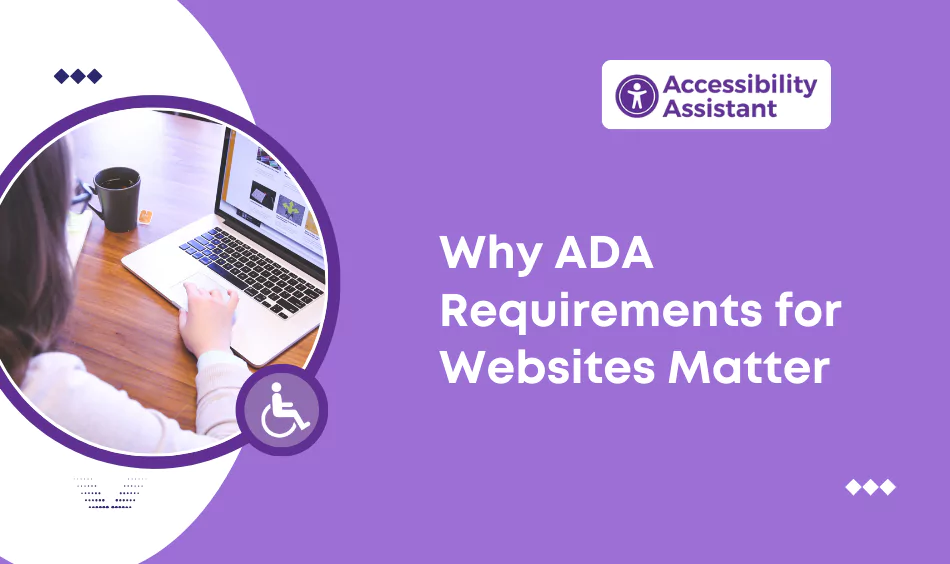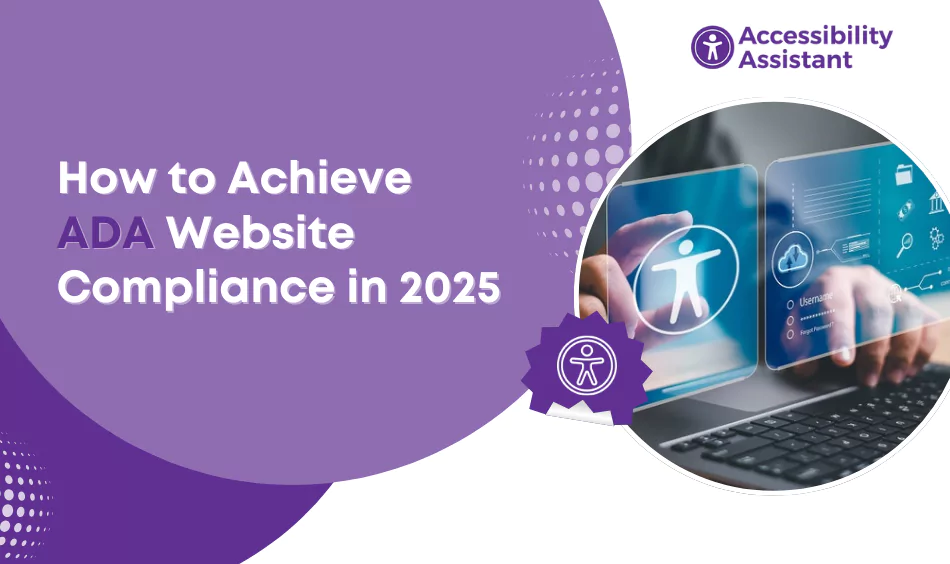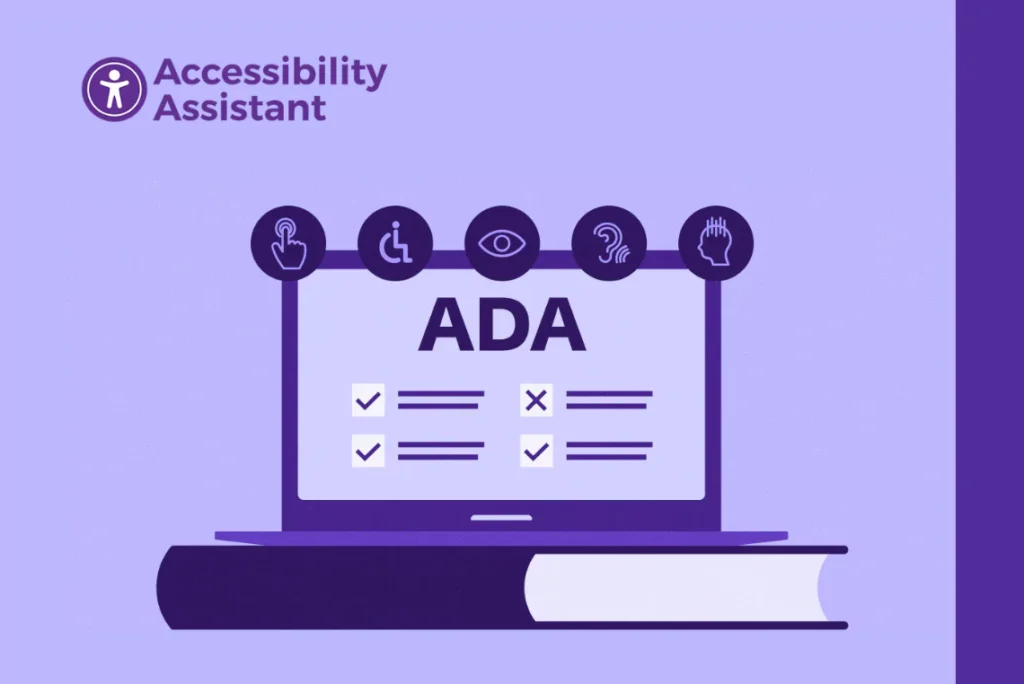Imagine losing clients because they couldn’t access your website. In today’s digital-first global world, accessibility isn’t always just an excellent practice; it’s a legal and ethical requirement. Businesses that fail to comply with ADA-compliant website requirements face lawsuits, penalties, and lost opportunities.
In this guide, we’ll explain ADA requirements for websites, why compliance matters, and how you can ensure your website meets accessibility standards. You’ll also learn about equipment, checklists, and real-world examples to help your business operate compliantly and user-friendly.
What Are ADA-Compliant Website Requirements?
The Americans with Disabilities Act (ADA) requires businesses to provide equal access to people with disabilities. This extends to digital platforms like websites and mobile apps.
ADA-compliant website requirements focus on making websites usable for individuals with visual, auditory, mobility, and cognitive impairments. These rules are based on WCAG (Web Content Accessibility Guidelines) and ensure inclusivity.
Key Components of ADA Website Compliance
- Text alternatives for images and non-text content
- Proper color contrast between text and backgrounds
- Keyboard navigability for all site functions
- Captions and transcripts for video/audio content
- Accessible forms with clear labels and error handling
If your website is not ADA-compliant, it could trigger lawsuits or alienate millions of users who rely on accessible design.
Many of the key components can be fixed quickly with tools. If you run an online store, the Accessibility Assistant Shopify App helps identify and resolve website ADA compliance requirements with ease, making your site accessible, compliant, and user-friendly.
Why ADA Requirements for Websites Matter
Building an accessible website isn’t just about avoiding legal trouble; it’s about creating growth opportunities, strengthening your reputation, and ensuring everyone can engage with your business. Meeting ADA-compliant website requirements delivers value to both companies and customers, making accessibility a smart business decision as much as a compliance necessity.

1. Legal Protection
Failing to comply with ADA requirements for websites exposes businesses to lawsuits, costly settlements, and reputational damage. Over the past decade, thousands of lawsuits have been filed against companies whose websites were not ADA-compliant. By following the website ADA compliance requirements, you significantly reduce legal risks and demonstrate responsibility toward inclusivity.
2. Expanded Market Reach
More than 61 million adults in the United States live with disabilities (CDC data). If your website is not accessible, you are potentially shutting out a massive audience. An accessibility compliance website ensures that customers with visual, hearing, mobility, or cognitive impairments can engage with your products and services.
3. Improved SEO Performance
Search engines like Google reward websites that follow ADA compliance standards. Practices such as adding alt text to images, structuring content with headings, and ensuring readable contrast overlap with SEO best practices.
4. Better User Experience
Accessibility improvements benefit all users, not just those with disabilities. For example:
- Captions help people in noisy environments.
- Clear navigation aids users browsing on mobile devices.
- Keyboard access supports power users and people with temporary injuries.
When you design with inclusivity in mind, you create a website compliance requirements model that ensures smoother interactions and fewer abandoned sessions.
5. Stronger Brand Loyalty
Customers want to support businesses that value inclusivity. A website not ADA-compliant can damage brand trust, while accessible websites signal responsibility and care. By meeting ADA compliance rules for websites, you show commitment to corporate social responsibility (CSR), which can strengthen long-term customer relationships, increase referrals, and build a positive brand reputation.
Want to know if your website meets accessibility rules? Begin with an audit and follow our complete guide to check website accessibility step by step.
Understanding Website ADA Compliance Requirements
Let’s break down the website compliance requirements aligned with ADA standards. These guidelines help ensure that digital platforms are accessible to all users, regardless of ability.
- Perceivable
Content must be presented in a way that everyone can perceive, including users with visual or hearing impairments.
- Provide alt text for images and graphics.
- Add captions and transcripts for videos and audio files.
- Use high-contrast colors to make text and visuals easier to read.
- Operable
Websites must be easy to navigate and usable with different input methods.
- All site functions should be accessible via keyboard navigation.
- Avoid time limits or ensure users can extend them.
- Provide clear focus indicators for clickable elements.
- Understandable
Content and interfaces should be clear, predictable, and simple to follow.
- Use readable fonts and plain language where possible.
- Ensure navigation and layouts are consistent across pages.
- Provide helpful error messages in forms and applications.
- Robust
Websites should be compatible with current and future technologies.
- Ensure content works well with assistive technologies like screen readers.
- Follow valid HTML/CSS coding standards.
- Test across multiple devices, browsers, and operating systems.
ADA Compliance Standards vs. WCAG Guidelines
Many businesses confuse ADA requirements for websites with WCAG guidelines. Here’s how they differ:
| ADA Compliance | WCAG Guidelines |
| Legal requirement in the U.S. | Internationally recognized accessibility standards |
| A broad law covering physical and digital accessibility | Technical guidelines for websites/apps |
| Enforced through lawsuits and settlements | Used as compliance benchmarks |
| Interpreted differently across industries | Defined checkpoints: WCAG 2.1, 2.2 levels A, AA, AAA |
The ADA doesn’t prescribe technical details, but compliance is judged against WCAG 2.2 AA.
Top Website Accessibility Errors to Avoid
Even with good intentions, many businesses fall short of full compliance. Common issues include:
- Missing alt text for product images
- Poor color contrast in branding and buttons
- Navigation menus that don’t work with keyboards
- Videos without captions or transcripts
- PDF documents not tagged for accessibility
- Forms without clear labels or error messages
These mistakes not only create accessibility barriers but also make your website not ADA-compliant, exposing you to legal risks.
How to Achieve ADA Website Compliance in 2025
Here’s a step-by-step guide to making your site accessible:

Step 1: Conduct an Accessibility Audit
Use tools like Accessibility Assistant for Shopify, WAVE, or axe to test compliance. Manual testing with screen readers like NVDA or VoiceOver is also essential.
Step 2: Fix Accessibility Issues
- Add alt text to all images
- Improve color contrast
- Ensure forms are properly labeled
- Add captions and transcripts to videos
- Check keyboard navigation paths
Step 3: Maintain Accessibility Ongoing
- Train your web team on accessibility best practices
- Review updates before publishing
- Perform annual audits to remain compliant
Step 4: Publish an Accessibility Statement
An accessibility compliance website statement shows your commitment to users and regulators. It should include:
- Your accessibility goals
- Contact information for reporting issues
- Compliance standards followed (WCAG 2.2 AA)
Case Study: Domino’s Pizza Website Not ADA Compliant
In 2019, Domino’s Pizza was sued because its website and mobile app didn’t work with screen readers. Blind customers couldn’t place online orders, as images lacked alt text and buttons weren’t labeled.
The case went to the U.S. Supreme Court, which upheld that businesses must make their websites accessible under the ADA compliance requirements for websites. Domino’s faced legal costs, negative publicity, and customer backlash.
Key Accessibility Failures in the Case
- The website did not work properly with screen readers, preventing blind customers from placing online orders.
- The mobile app lacked proper alt text for images and had unlabeled buttons, making navigation impossible.
- The digital platforms failed to meet basic WCAG 2.1 AA standards, which are widely recognized benchmarks for ADA website compliance requirements.
Lesson: Even global brands aren’t safe. Ensuring your website is ADA-compliant protects your business from lawsuits and builds trust with all customers. Tools like the Accessibility Assistant Shopify App make achieving compliance easier.
FAQs on ADA Compliance Standards for Websites
- What is required for a website to be ADA-compliant?
A website must meet WCAG 2.2 AA guidelines, ensuring accessibility for users with visual, hearing, mobility, or cognitive disabilities. - How to determine if a website is ADA compliant?
Run accessibility audits using tools like Accessibility Assistant App, WAVE, or axe, and perform manual screen reader testing. - What does an ADA-compliant website look like?
It offers alt text, captions, clear navigation, proper contrast, and keyboard access, making content usable for everyone. - How do I certify my website is ADA-compliant?
There’s no official certificate; businesses demonstrate compliance through audits, remediation, and publishing an accessibility statement. - Who needs to follow ADA requirements for websites?
All businesses offering goods or services online in the U.S. - Can Proceed Innovative help improve website accessibility and ADA compliance?
Yes. Proceed Innovative can help enhance your website accessibility and ensure ADA compliance by identifying barriers, fixing WCAG violations, and optimizing user experience for people with disabilities. Pairing their services with tools like the Accessibility Assistant Shopify App can make achieving and maintaining compliance faster and more cost-effectively.
Conclusion
ADA compliance is not optional; it’s a business requirement. Following ADA-compliant website requirements protects you legally, improves user experience, and builds trust with your customers.
Whether you’re running an e-commerce store, a service-based business, or a corporate site, meeting ADA compliance requirements for websites ensures inclusivity and long-term success.
Test your website today with the Accessibility Assistant Shopify App or schedule a professional audit to ensure your website compliance requirements are fully met.

